Lablab Insect Pests
Lablab Insect Pests
Jassid
Biology:
- Egg: Female inserts eggs into leaf veins on the underside. Eggs hatch in 6-10 days
- Nymph: Nymphs are pale greenish almost translucent and walk diagonally. Nymphal period is 6-10 days.
- Adult: Adults are greenish yellow, wedge shaped with a pair of black spots on vertex and a black spot on each of the forewings. Adult stages last for 35-50 days depending upon weather conditions. There are a total of 7-8 generations in a year.
Life cycle:
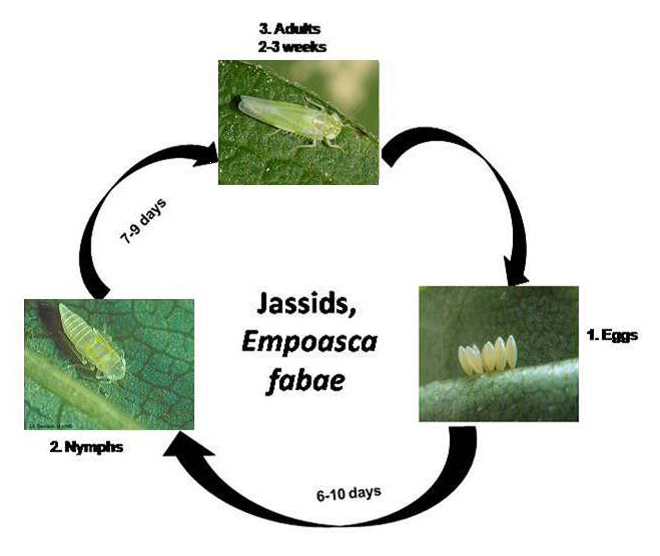
Damage symptoms:
- The infected leaves show pale yellow coloration.
- In case of heavy infestation, the leaves curl .
- The leaf edges turn light pinkish brown.
- Stunted growth of plant, cupped and crinkled leaves, burnt appearance of leaf margins are symptoms of damage.
Pod borer
It is a polyphagous and polymorphous pest infesting, pea, lablab, safflower, sunflower, chillies, pulses, groundnut, tobacco, cotton etc.
Biology:
- Egg: The spherical, yellowish eggs are laid singly on tender parts and buds of plants. The egg period lasts for 2-5 days.
- Larva: Caterpillars vary in colour, initially brown and later turn greenish with darker broken lines along the side of the body. The larval period lasts for 18-25 days. Body covered with radiating hairs. When full grown, they measure 3.7 to 5 cm in length. The full grown caterpillar pupates in the soil in an earthen cell and emerges in 16-21 days.
- Pupa: Pupation takes place inside the soil. Pupal stage lasts 7-15 days.
- Adult: Moth is stout, medium sized with brownish/greyish forewings with a dark cross band near outer margin and dark spots near costal margins, with a wing expanse of 3.7cm.
Life cycle:
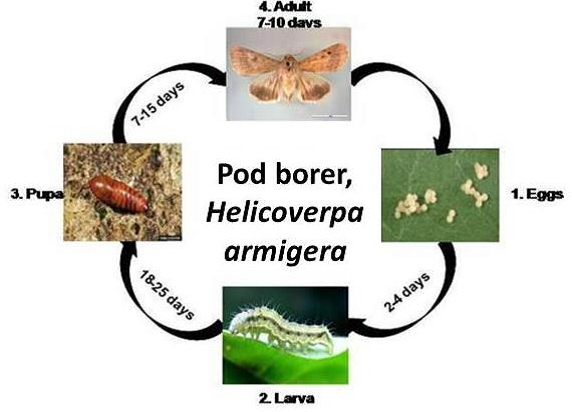
Damage symptoms:
- Young larva feeds on flower and flower buds and then attacks pods. Internal tissues are eaten severely and completely hollowed out. While feeding the caterpillar typically thrust its head inside leaving the rest of the body outside.
- Infested pods can be easily be identified by bores with round holes.

Natural enemies of pod borer:
- Parasitoids: Trichogramma spp, Tetrastichus spp, Chelonus spp, Telenomus spp, Bracon spp, Ichneumon spp, Carcelia spp,Campoletis spp, Senometopia illota
- Predators: Lacewing, lady beetle, spider, fire ant, dragon fly, robber fly, reduviid bug, preying mantid, black drongo, wasp, common mynah
Pod borer
It is a serious pest of leguminous vegetables viz., cowpea, red gram, mung bean, urd bean, lablab, French bean etc.
Biology:- Egg: The eggs of are laid either singly or in small batches on flowers, flower buds, tender pods. The eggs hatch in 3- 7 days depending up on weather conditions.
- Larva: Neonate larvae initially may be found in-group on flowers, later they disperse moving from one flower to another so that each larva damages number of flowers, flower buds. They also f
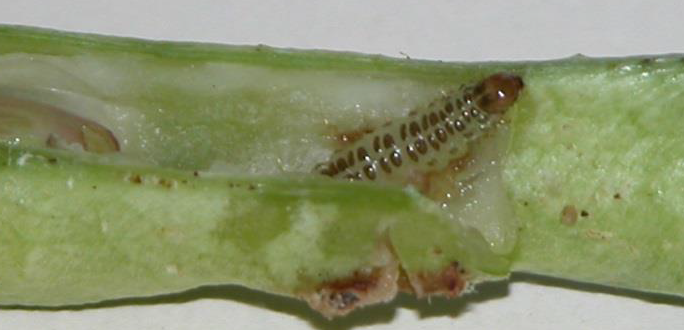 eed on the young pods and thereby making them unfit for human consumption. The larval stage lasts for 13-17 days.
eed on the young pods and thereby making them unfit for human consumption. The larval stage lasts for 13-17 days. - Pupa: There is a brief pre-pupal for 1-2 days and the pupal stage takes about 6-7 days.
- Adult: Moth in medium sized with brownish-black wings. Fore wings have a conspicuous transverse white elongate marking.
- During flowering stage, it feeds on the flower buds and flowers and causing premature flower dropping.
- At later stage they feed on the seeds of the tender pods resulting in economic loss. The damaged pod has a large emergence hole made by the pupating larva.
- Parasitoids: Trichogramma spp,Tetrastichus spp, Chelonus spp, Telenomus spp, Bracon spp,Ichneumon spp, Carcelia spp,Campoletis spp, Senometopia illota
- Predators: Lacewing, lady beetle, spider, fire ant, dragon fly, robber fly, reduviid bug, preying mantid, black drongo, wasp, common mynah
Bean aphids
Biology:- Nymph: Aphids are mostly viviparous and reproduce thorough parthenogenesis. There are four nymphal stages (instars). The general appearance of each stage is similar except for increase in size during subsequent instars. The first, second, third and fourth nymphal stages generally last for 1-2, 2, 2 and 3 days respectfully.
- Adult: Aphids are small, soft-bodied, pear-shaped insects that have a pair of cornicles (wax-secreting tubes) projecting out from the fifth or sixth abdominal segment. Wingless (apterous) female aphids are black or blackish brown with a white waxy bloom covering the body. The aphid attacks generally during 2nd and 3rd week of December and continues till March.
Life cycle:
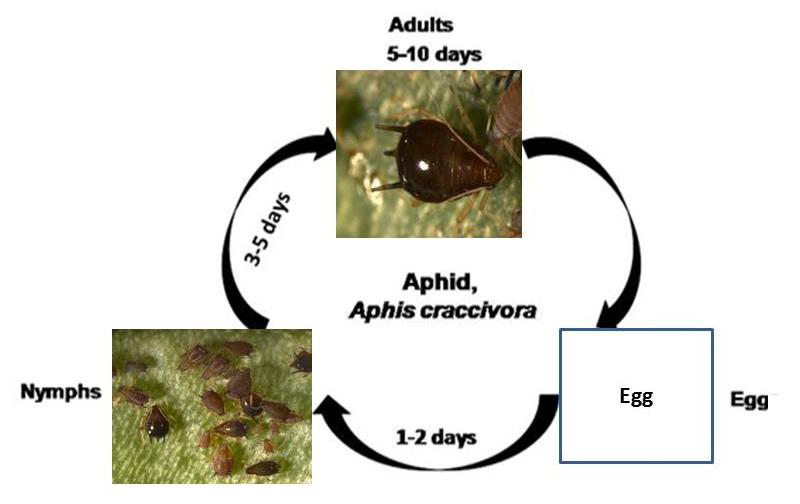
Damage symptoms:
- Both nymph and adults suck the sap from leaves, buds, flowers and pods.
- Curling may occur for infested leaves and at advanced stage plants may wither and die.
- Plants remain stunted and sooty molds grow on the honey dew excreted by these insects.

Natural enemies of bean aphids:
- Parasitoids: Diaeretiella rapae, Aphelinus abdominalis etc.
- Predators: Lacewing, lady bird beetle, hover fly etc.
Red spider mite
Biology:The red spider mite normally completes its life-cycle from egg to adult in about a week. All stages of this mite are present throughput the year. Reproduction is most favorable when the weather is hot and dry.
- Egg: Eggs are spherical, shiny, straw colored, and hatch in 3 days. They are only about 1/254 inch in diameter. They are laid singly on the underside of the leaf surface or attached to the silken webs spun by the adults.
- Larva: Larvae are slightly larger than the egg, pinkish, and have three pairs of legs. This stage lasts a short time, perhaps a day.
- Nymph: There are two nymphal stages, the protonymph and deutonymph. The nymphal stage differs from the larval stage by being slightly larger, reddish or greenish, and having 4 pairs of legs. This nymphal stage lasts about 4 days.
- Adult: Adult females are about 1/50 inch long, reddish, and more or less elliptical. The males are slightly smaller and wedge shaped. They have a black spot on either side of their relatively colorless bodies. The adult female may live for up to 24 days and lay 200 eggs.
Life cycle:
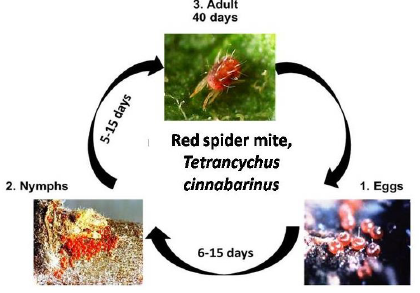
Damage symptoms:
- Red spider mite feeds on leaves.
- Severe mite injury produces browning and loss of colour in the leaves i.e. yellowing, bronzing and curling of leaves.
Predators: Coccinellid, lace wing, predatory mite
Whitefly
Biology:Nymphs are oval, scale like and remain attached to the leaf surface. Adults are tiny, moth like with yellowish body and wings coated with milky white waxy powder.
- Egg: Pear shaped, light yellowish Stalked
- Nymph: On hatching Oval, scale-like, greenish white
- Adult: White, tiny, scale-like adult
Life cycle:
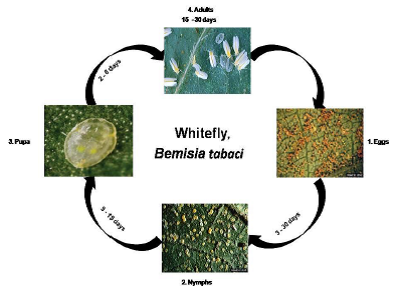
Damage symptoms:
- Nymphs and adults suck sap and excrete honeydew.
- A secondary infection develops when a black sooty mould fungus grows on the sticky honeydew.
- There are no visible damage symptoms with low numbers of whiteflies.
- Under very heavy infestations, plants lose vigour and damage is manifested under severe moisture stress, causing leaf wilting and failure to set seed.
- Warm weather conditions are favourable for multiplication.
- Parasitoids: Encarsia formosa, Chrysocharis pentheus, Eretmocerus spp.
- Predators: Mirid bug, green lacewing, lady beetle, big-eyed bugs
Stem fly
Biology:- Egg: The stem fly inserts eggs on the underside of young leaves on tender stems. Ovipositing sites present as pale pinprick spots when infested leaves are held up to the light.
- Larva: The larvae are apodus, whitish, cigar -shaped maggots that reach little more than 2mm. Larva pupate after 8-11 days. Before pupation, which takes place inside the stem, the larva makes an exit hole for the emergence of the adult.
- Pupa: Pupae are smooth, light brown to pale brown, cylindrical in shape with rounded ends. Pupal stage lasts 6–12 days.
- Adult: Adult flies are shiny black and about 2mm long with a pair of clear wings of wingspan 4-5 mm.
Life cycle:
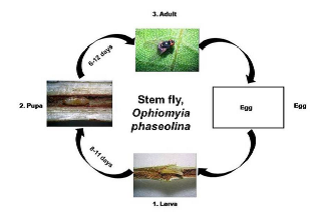
Damage symptoms:
- Infected stems are often red inside (sometimes pale) and a distinct zig-zag tunnel filled with frassy excreta may be observed with maggots or pupae inside. Apart from the exit holes, the plants may apparently appear healthy from outside.
- Severe infestations (3 or more maggots per plant) may cause wilting, yellowing, drying and finally pre-mature plant death, especially in younger plants particularly if damage occurs in the plant’s hypocotyl (basal stem) region.
Parasitoids: Tiny wasps
Pod bug
Biology:Pod bugs are serious pests in many parts of the country particularly Andhra Pradesh, Tamil Nadu, Madhya Pradesh, Delhi, Uttar Pradesh, Bihar, West Bengal etc.
Andhra Pradesh, Tamil Nadu, Madhya Pradesh, Delhi, Uttar Pradesh, Bihar, West Bengal etc.
Egg: Adult lays eggs in small batches of 8-15 mostly on pods. Incubation period ranges from 3-6 days depending upon weather condition.
Nymph: Nymphs are smaller in size and devoid of wings, nymphal period completes within 8-17 days.
Adults: Adult legs are bigger in size and with two pairs of wings.
Damage symptoms:- Both the nymphs and adults sucks the sap from seeds of developing pods through pod wall.
- Affected pods show clear brown spots on the pods, seeds become shrivelled and lose viability
Root-knot nematode
- The life cycles root-knot (Meloidogyne sp.), its sedentary endoparasites.
- The invasive or second stage juvenile (J2) hatches from the egg and seeks a feeding site within a root.
- The juvenile moults to the J3 and begins enlarging as the reproductive system develops. Nematodes which become females are no longer able to leave the root.
- They continue to enlarge as they go through the J3 and J4 stages. Root-knot nematode, galls will typically develop on the root.
- Upon becoming adults, root-knot nematodes will begin to lay eggs (up to several hundred) which are contained in a gelatinous matrix at the posterior end of the body.
- The egg mass may be within the root or partly or wholly exposed on the root surface while the swollen body of the female remains within the root.
- Eggs in matrices often remain attached to root fragments in the soil after the female dies.
- Root-knot egg and juvenile populations decline by up to 70 to 90 percent during winter in the absence of reproduction.
Life cycle:
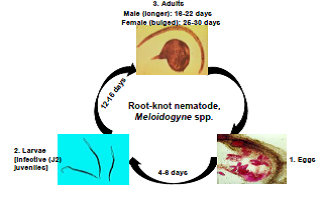
Life stages are microscopic in size
Damage symptoms:- Infections by root-knot nematode cause decline in the host, and under some conditions, may kill the plant.
- Infected plants may be stunted and chlorotic, usually wilt easily, and are not productive. However, the extent of damage caused by root-knot nematode infections varies with host, timing of infection, and cultural conditions. Root-knot nematode infection often is easy to identify because of the swellings in roots that look like “knots.”
- The swellings become large and easy to see on some hosts such as squash, but may be smaller and less conspicuous on others such as chile pepper.
- Multiple infections on one root result in a swollen, rough appearance. Root-knot nematodes are very small and can only be observed using a microscope.
- Primary: Cysts and egg masses in infected plant debris and soil or collateral and other hosts like Solonaceous, Malvaceous and Leguminaceous plants act as sources of inoculum
- Secondary: Autonomous second stage juveniles that may also be water dispersed
Loamy light soils
IPM for Lablab
To know the IPM practices for Lablab , click here.
Source: NIPHM, Directorate of Plant Protection, Quarantine & Storage
Last Modified : 4/1/2020
This topic covers the information related to Insec...
This topic covers the information related to Insec...
This topic covers the information related to Insec...
This topic covers the information related to Insec...
